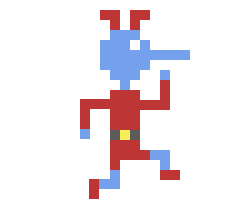 As we approach our animation tasks, it’s worth diving into a topic that relates to animation, and that’s frame rate, usually measured in frames per second. Literally, frames per second refers to the number of visual “pictures” or screens that are shown every second, and despite our advances in technology over the last century and change, we still rely on the same principles of showing moving pictures that they used with old zoetropes (the round box with slots that showed a series of pictures as it rotated).
As we approach our animation tasks, it’s worth diving into a topic that relates to animation, and that’s frame rate, usually measured in frames per second. Literally, frames per second refers to the number of visual “pictures” or screens that are shown every second, and despite our advances in technology over the last century and change, we still rely on the same principles of showing moving pictures that they used with old zoetropes (the round box with slots that showed a series of pictures as it rotated).
Those principles rely on human imperfection (or skill depending on how you look at it) and our natural talent for filling in gaps in information with our imagination. According to which source you read, the human eye can perceive anywhere from up to 200fps to 1000fps, but a range somewhere between 18 – 24fps is often enough for the brain to fill in the gaps without perceiving jerky movement, which is why most films have been doing fine at 24fps. Of course, other factors like how fast the subject is moving, whether motion blur is being applied, etc. can all impact how jerky different frame rates appear. In some cases, movie makers might even film at a lower frame rate without motion blur or other compensation to make the action on the screen appear chaotic – like in heated battles during a war movie, for example. For more information on what different frame rates look like in action scenes, this video featuring Douglas Trumbull is a fantastic start.
But when it comes to games, the number of frames per second a game runs at affects more than just visuals, it can affect gameplay in some cases, and, at the very least, it usually affects player input. If a game runs at 30fps, it means there are 30 opportunities every second to accept player input. That seems like a lot, but humans are pretty sensitive, and gamers are even more sensitive. Depending on the game, 30fps could feel a bit sluggish or “framey”. On the other hand, some people feel that certain games look or feel better at 30fps. Of course, the debate between which is better is still raging, and everyone has their preference, so there’s no right or wrong answer (even if some people feel there is). The important thing isn’t to be “right” but to be aware that there are pros and cons to going with different frame rates, and that it’ll affect the feeling of the game as well as its visuals.
Even if you’re set on a certain frame rate when designing a game, it’s best to avoid coding around a fixed frame rate, because there’s always a chance that later on you’ll want to change it. That change might even come years down the line if you end up porting it to another platform or decide to upgrade the graphics, and you don’t want to have to hunt through a half-forgotten project for spots using a predetermined frame rate!